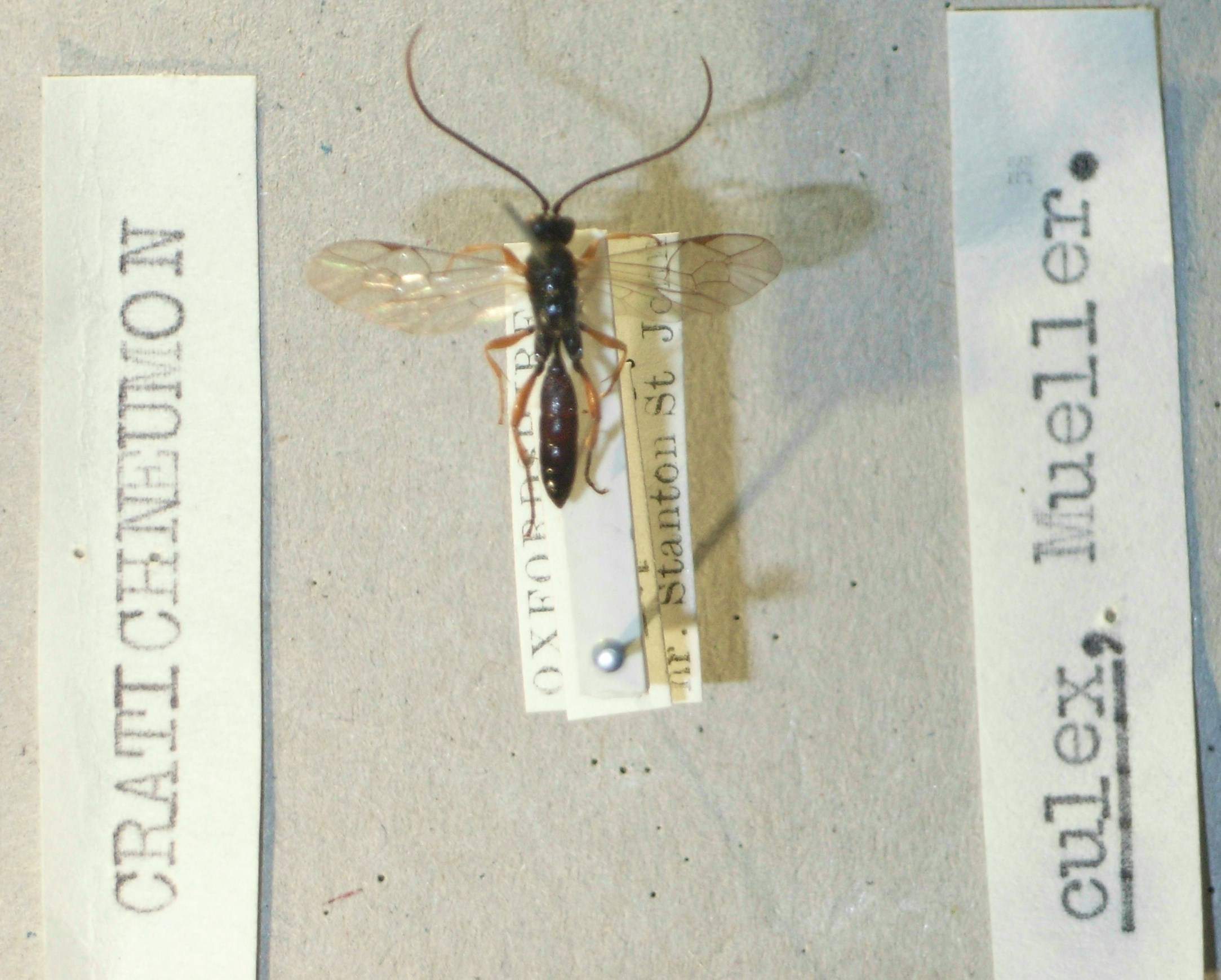Cratichneumon Culex on:
[Wikipedia]
[Google]
[Amazon]
''Cratichneumon culex'' is a species of the
 ''Cratichneumon culex'' can reach a length of (excluding antennae). As usual in Incheumonidae these solitary parasitic wasps have an elongated abdomen and very long antennae. The body is black, while the legs are reddish or reddish with white markings and the antennae are partially white.
''Cratichneumon culex'' can reach a length of (excluding antennae). As usual in Incheumonidae these solitary parasitic wasps have an elongated abdomen and very long antennae. The body is black, while the legs are reddish or reddish with white markings and the antennae are partially white.
''Larentinae I''
/ref>
Barry Fotopage
Ichneumonidae Insects described in 1776 Taxa named by Otto Friedrich Müller {{Ichneumonidae-stub
parasitic wasp
Parasitoid wasps are a large group of hymenopteran superfamilies, with all but the wood wasps (Orussoidea) being in the wasp-waisted Apocrita. As parasitoids, they lay their eggs on or in the bodies of other arthropods, sooner or later causin ...
of the family
Family (from la, familia) is a Social group, group of people related either by consanguinity (by recognized birth) or Affinity (law), affinity (by marriage or other relationship). The purpose of the family is to maintain the well-being of its ...
Ichneumonidae
The Ichneumonidae, also known as the ichneumon wasps, Darwin wasps, or ichneumonids, are a family (biology), family of parasitoid wasps of the insect order Hymenoptera. They are one of the most diverse groups within the Hymenoptera with roughly 2 ...
. The species was first described by Müller in 1776.
Description
Distribution and habitat
This species can be found in most of Europe. It lives in hedge rows.Biology
This species is a pupal parasitoid. Adults parasite the pupae of the winter moth ''Operophtera brumata
:''In North America, "winter moth" usually denotes the invasive species ''Operophtera brumata'', but may also mean refer to a native species, ''Erannis tiliaria'' (linden looper) or '' Operophtera bruceata'' (bruce spanworm).''
The winter moth (' ...
''. Other recorded hosts are '' Semiothisa'' species and ''Bupalus piniarius
__NOTOC__
The bordered white or pine looper (''Bupalus piniaria''), is a moth of the family Geometridae. Among these, it belongs to tribe Bupalini of the subfamily Ennominae. ''B. piniaria'' is a common species throughout the western Palearctic r ...
'' (Geometridae
The geometer moths are moths belonging to the family Geometridae of the insect order Lepidoptera, the moths and butterflies. Their scientific name derives from the Ancient Greek ''geo'' γεω (derivative form of or "the earth"), and ''met ...
), ''Tethea or
''Tethea or'', the poplar lutestring, is a moth of the family Drepanidae. It was first described by Michael Denis and Ignaz Schiffermüller in 1775. The species can be found in Europe, northern and eastern Asia and Japan. The imago resembles '' T ...
'' (Drepanidae
The Drepanidae are a family of moths with about 660 species described worldwide. They are generally divided in three subfamilies) which share the same type of hearing organ. Thyatirinae, previously often placed in their own family, bear a super ...
), ''Notodonta dromedarius
''Notodonta dromedarius'', the iron prominent, is a moth of the family Notodontidae. The species was first described by Carl Linnaeus in 1767. It is found in Europe and Anatolia.
The wingspan is 35–40 mm. ''Notodonta dromedarius'' has gr ...
'' (Notodontidae
Notodontidae is a family of moths with approximately 3,800 known species. The family was described by James Francis Stephens in 1829. Moths of this family are found in all parts of the world, but they are most concentrated in tropical areas, espe ...
), ''Dasychira pudibunda
''Calliteara pudibunda'', the pale tussock, is a moth of the family Erebidae. The Dutch common name for the moth (''Meriansborstel'') comes from the butterfly and insect painter Maria Sibylla Merian. The species was first described by Carl Linna ...
'' (Lymantridae
The Lymantriinae (formerly called the Lymantriidae) are a subfamily of moths of the family Erebidae. The taxon was erected by George Hampson in 1893.
Many of its component species are referred to as "tussock moths" of one sort or another. The cat ...
) and ''Panolis flammea
The pine beauty (''Panolis flammea'') is a moth of the family Noctuidae. It is a common species of pine woods in Europe. The distribution area extends from the west of Catalonia over southern France, central Italy, central Europe to western Si ...
'' (Noctuidae
The Noctuidae, commonly known as owlet moths, cutworms or armyworms, are a family of moths. They are considered the most controversial family in the superfamily Noctuoidea because many of the clades are constantly changing, along with the other f ...
). These wasps are mainly active in the late summer. They search for their prey in the soil. The females lay eggs into pupae with the ovipositor.Hausmann, Axel & Viidalepp, Jaa''Larentinae I''
/ref>
References
External links
Barry Fotopage
Ichneumonidae Insects described in 1776 Taxa named by Otto Friedrich Müller {{Ichneumonidae-stub